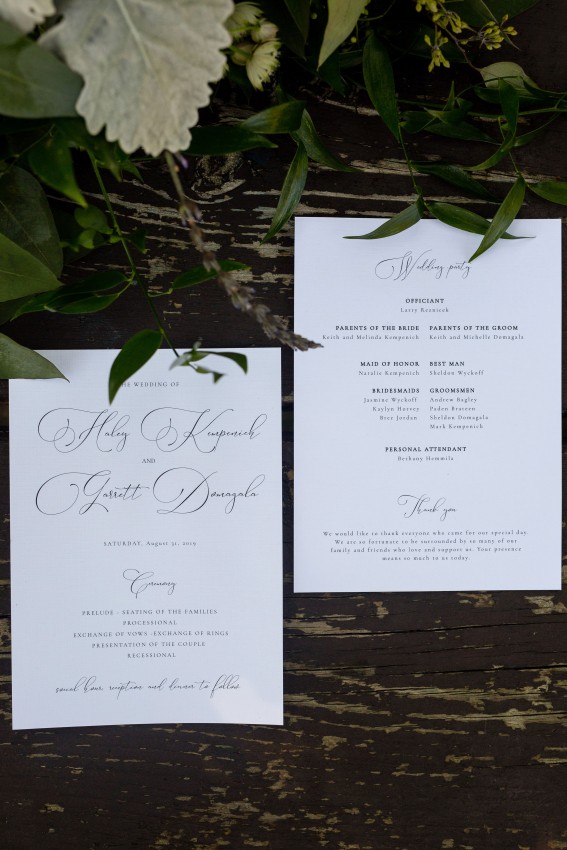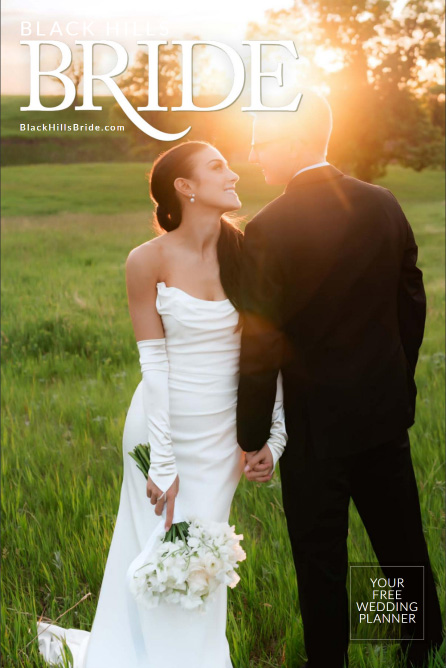Wedding Ceremony 101
Your wedding ceremony should be as unique as your love story. Learn the pieces and parts — and some tips for making the ceremony your own!
The entire purpose of your wedding day is to celebrate the love between you and your partner. Beyond all the catering decisions and centerpiece design, the heart and soul of your day is the wedding ceremony, and it should be as unique as you are.
If you’re wondering about writing your own ceremony, we’ve broken it down for you step-by-step. If you get stuck or even overwhelmed, have no fear! There are great officiants throughout the Black Hills that can help make sure your day is a reflection of you.
Set the Stage
This is when whoever is officiating will enter, either down the aisle or from the side somewhere. You can choose to have them introduce themselves, make any remarks about the ceremony (no flash photography, shut off cell phones, get a drink at the bar, whatever). Or they can simply stand; their presence is a great sign that the show is about to start.
The Grand Entrance
Fairly self-explanatory, but get creative. Have your bridal party dance down the aisle, or skip, or spin, whatever you want to do. The way everyone enters will set the tone for the rest of the ceremony, so make a great first impression. Also consider how you want to walk down the aisle—it is your big day after all—this is where you pick your song, who is going to walk with you, and whether you want to be “given away.”
The Welcoming
Not that people need reminding why they’re here, but it’s nice to welcome them and thank them for coming. This is where your officiant should thank everyone for coming on behalf of you and your partner, and also your parents (especially if they were a major part of financing the wedding. It’s tradition, but also courtesy.)
This is also a good time for any specific highlights or remembrances, such as giving flowers or gifts to parents and grandparents, or taking a moment to acknowledge family and friends who have passed that you wish could have spent the day with you.
If you’re doing any sort of crowd-involved ritual or tradition, such as a ring warming, now is a great time to explain it and get it started so the rings have time to travel back up front in time for you to exchange them.
Marriage Address
This is where you introduce you as a couple and tell your love story. How did you meet, when you knew it was love, all the fun stories that people love to hear at weddings. We’re here to celebrate you, so tell us all the things we’re celebrating!
If you’re having a traditional or faith-based ceremony, this is generally where the sermon or homily will take place. Other readings, religious or secular, can also go here, as well as music, poetry, or other personal touches.
The Declaration of intent
Get ready to say “I do!” Face one another, hold hands, and pretend there’s nobody else in the room as you declare your intentions to love each other forever.
This is another section that can be the more traditional religious readings, or create your own.
Unity Ritual
While the most common is lighting a unity candle, there are lots of options to personalize this to your specific tastes. Handfasting, sand pouring, even building a cross together are popular options that you can find kits for online. This is a great time to do a reading or a poem symbolizing you becoming one.
Something to note here is to be aware of your ceremony location. Outdoor ceremonies come with unpredictable weather, and it's awkward to watch as you struggle to keep candles lit. Consider having a backup, or maybe going with a less traditional ritual to prevent any snags.
See our list of unity ritual ideas here.
Vows and Rings
This is where you usually have the “repeat after me” style readings, but you don’t have to stick to that format. Some couples read their own vows off a piece of paper; having your officiant hold on to it for you is a great way to make sure you don’t forget it. Braver souls memorize them—but be careful! Your nerves might get the best of you, so having them written down as a backup is a safe bet.
This is also a great time to do a ring blessing, if you’d like, before placing the ring on your partner’s finger. It’s worth mentioning that your nerves may get the best of you and you might get the wrong finger, or drop a ring—no worries! It happens, and actually quite frequently. Don’t let it derail your ceremony, just smile and know that it’ll be a funny story someday.
Declaration of Marriage and Closing Remarks
You’ve said the things, exchanged the rings, now we’re almost there!
Now is a great time for any final blessings, intentions, music pieces or poetry you would like to share that symbolizes you beginning your life together. If you have bubbles, flower petals or something you want guests to toss as you walk out, this is also a good place to have your officiant make a brief announcement about it.
Next comes everyone’s favorite part—seal the deal with a kiss! How exuberant of a kiss is up to you; don’t feel you have to settle for a peck, but don’t get too carried away either.
There are a few rituals that take place just after the marriage is made official, such as the breaking of the glass, the jumping of the broom, or a military saber arch. If you are including any of these elements, or want guests to stay by their seats for any reason, it’s helpful for your officiant to announce this.
Recessional
Just like the processional, the recessional can either be traditional or a fun way to kick-start the reception. Once you’ve walked back down the aisle, this is where it’s a good idea to do a receiving line if you’re having one.
That’s it! That’s all the moving pieces of a ceremony. You can do as much or as little with each section as you and your partner want to. Add in music, poetry, religious texts, whatever suits you as a couple. Just remember that your wedding day is ultimately about celebrating you as a couple and your love story.


